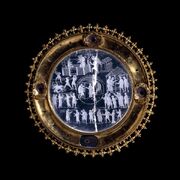
Lothair Crystal. Made between 855-869 in present day Germany for King Lothair II
Brief Identification[]
The Lothair Crystal, also referred to as the Susanna Crystal, is an engraved rock crystal that currently resides in the British Museum . It was produced between 855-869 CE during King Lothair II rule and depicts the story of Susanna from the Bible. It was produced in what is now present day Germany and served as a piece of art and possibly a symbol for law at the time. It is 18.6 cm wide and has a depth of 1.39 cm making it relatively small piece of artwork.
Technical Evaluation[]
The Lothair Crystal is a very unique piece of artwork. It is a single piece of clear crystal and was “form[ed] from pure snow” which was probably used “to symbolize purity of faith” (Kornbluth, 27). The artist of the piece is not known, but whoever the artist was hand engraved the scenes found on this crystal. The Lothair Crystal is “elaborately engraved with forty-one figures” and was done so completely by hand (Kornbluth, 25). The crystal is able to be traced back to King Lothair II because of the “prominent inscription [that] draws attention to the patronage of Lothair II” who ruled from 855-869, and because of this is “one of very few objects from the early Middle Ages datable with precision” (Kornbluth, 25). The piece was cracked and thrown into the Meuse river in 1793 and was finally acquired by the British Museum in 1855.
Local Historical Context[]
The Lothair Crystal was produced during a time of great change in Europe at the time. King Lothair II was granted land to rule over upon his father’s, Lothair I, death in 855. He was given the lands known as Lotharingia which was most of the lands located north of the Alps in present day Germany. This area was claimed by Charlemagne in the late 8th century when “he launched a 30-year campaign that conquered and Christianized the powerful pagan Saxons in the north...and By 800 was the undisputed ruler of Western Europe”.
During Lothair II’s rule, the rise of the Christian church was taking place in Europe. In this society, the king ruled over everyone and most people were serfs who worked on farms. There was also a class of skilled laborers from which this crystal was probably engraved. The Lothair Crystal is “connect[ed] with the divorce of Lothair II” and was most likely the reason it was engraved during this time period (Kornbluth, 25). The crystal is engraved with depictions from the story of Susannah in the Bible. This engraving shows scenes of Susannah being approached by elders who have accused and convicted her of adultery. The last depiction shown is of Daniel questioning these elders ultimately leading to Susannah being declared innocent.
One theory concerning its creation follows that Lothair tried to divorce his wife unjustly to marry another woman bearing his son by proving that she had committed adultery. King Lothair was “forced by Rome to acknowledge [her] innocence” and it is argued that he “ordered the Susannah Crystal made for [her] to show sincere acknowledgement of her innocence” (Kornbluth, 25). Others believe the Lothair Crystal was “was intended to exemplify the proper functioning of justice”, but this too is ironical as “Lothair tried many times to have his marriage annulled so he could marry his mistress, which resulted in a bitter dispute between Lothair and Pope Nicholas I”. These are just a few possible explanations for why this crystal was engraved.
World-Historical Significance[]
The Lothair Crystal was produced during not only the rise and spread of Christianity all over Europe, and was a example of the influence that accompanied Christianity. Through Charmlemagne’s earlier conquest of much of Europe, Christianity was also spread into these conquered areas. The Lothair Crystal shows the influence that the church had on government and law because it “focused on the judicial process”, and the crystal strongly “emphasizes the political message” engraved in it (Kornbluth, 31,33). The Christian church’s influence over government and law during this time can be seen through the Lothair Crystal. Similar scenes from the Bible were produced to show what was considered the right thing, such as stained glass windows in churches or paintings describing a scene. The rapid spread and acceptance of Christianity during this time allowed for the Lothair Crystal and many other forms of Biblical art to exemplify the idea that law and justice were shaped heavily by religion.
Suggested Bibliography[]
Kornbluth, Genevra. "The Susanna Crystal of Lothar II : Chastity, the Church, and Royal Justice." Gesta 31.1 (1992): 25-39. ATLA Religion Database. EBSCO. Web. 20 Apr. 2011.
"The Historical Charlemagne." UCLA Humanities Division. 1991. Web. 20 Apr. 2011. <http://www.humnet.ucla.edu/santiago/histchrl.html>.
"Lothair Crystal › The British Museum." The British Museum › Welcome to the British Museum. Web. 20 Apr. 2011. <http://www.britishmuseum.org/explore/highlights/highlight_objects/pe_mla/t/lothair_crystal.aspx>